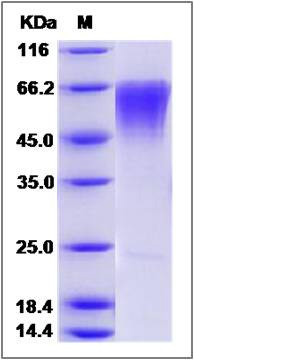Human CLM-9 / TREM4 / CD300LG Protein
CLM-9,CLM9,NEPMUCIN,TREM-4,TREM4
- 100ug (NPP2028) Please inquiry
| Catalog Number | P13365-HCCH |
|---|---|
| Organism Species | Human |
| Host | Human Cells |
| Synonyms | CLM-9,CLM9,NEPMUCIN,TREM-4,TREM4 |
| Molecular Weight | The recombinant human CD300LG consists of 236 amino acids and predicts a molecular mass of 25.5 KDa. It migrates as an approximately 61-66 KDa band in SDS-PAGE under reducing conditions. |
| predicted N | Leu 19 |
| SDS-PAGE |  |
| Purity | > 95 % as determined by SDS-PAGE |
| Protein Construction | A DNA sequence encoding the human CD300LG (AAH25395.1)(Met1-Arg247) was expressed with six amino acids (LEVLFQ) at the C-terminus was expressed and purified. |
| Bio-activity | |
| Research Area | Neuroscience |Cell Adhesion Proteins |Cytoskeletal Proteins |Microfilaments |Actin etc |Actin Binding Proteins | |
| Formulation | Lyophilized from sterile PBS, pH 7.4. 1. Normally 5 % - 8 % trehalose and mannitol are added as protectants before lyophilization. Specific concentrations are included in the hardcopy of COA. |
| Background | CLM-9, also known as TREM4, is a receptor which belongs to the TREM family. The TREM family of receptors regulates the activity of various cell types of the immune system including neutrophils, monocyte/macrophages, microglia, and dendritic cells. CLM-9 may mediate L-selectin-dependent lymphocyte rollings. It binds SELL in a calcium dependent manner. CLM-9 also binds lymphocyte which suggests that it functions in lymphocyte adhesion. The major CLM-9 transcript is expressed highly in human heart, skeletal muscle, and placenta. The mouse protein has been shown to be expressed in capillary endothelial cells. Human CLM-9 mediates the uptake of human IgA2 and mouse IgM. |
| Reference |
